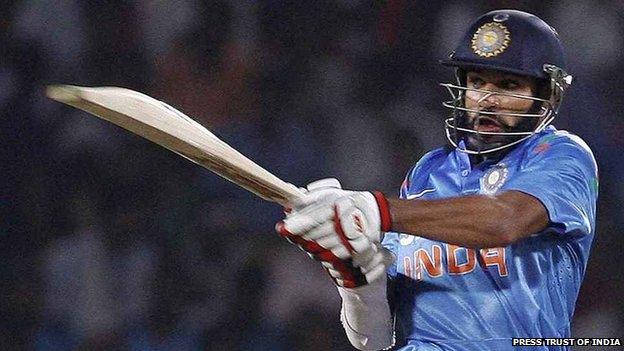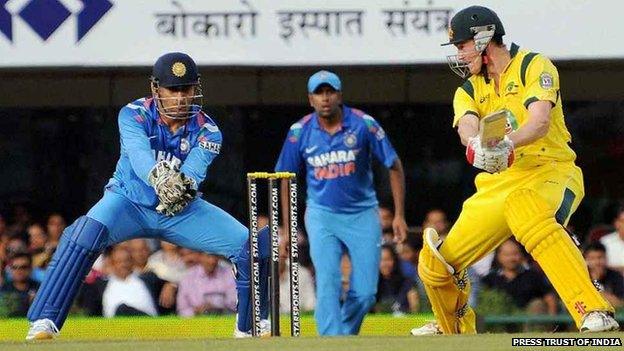Are bowlers under threat in one-day cricket?
- Published

India chased down a target of over 350 runs twice in the ongoing series against Australia
Batsmen have chased down successfully targets of over 300 runs twice in four completed games in the ongoing one-day cricket series between India and Australia. Sports writer Suresh Menon examines whether the bowlers are under threat in the shorter version of the game.
In the early years of one-day international cricket, 250 runs from 50 overs was considered a good score.
Once the asking rate went up to six an over in the chase, it was assumed the game had gone out of reach for the team batting second.
Today, 300 is a par score at most venues, 350 a good one and so long as the asking rate is kept around eight an over, the chase is on track.
Progress? Or its reverse? Is batting in one-day cricket getting too good for its own good? Are the seeds for the elimination of this format being sown by the game's rulemakers?
If a match has twice produced over 700 runs in the India-Australia ODI series, don't blame the rules alone.
Mediocre
We must acknowledge that the two sets of bowlers have been depressingly mediocre.
Even Mitchell Johnson, the man who rattled India's middle order (meaning Suresh Raina and Yuvraj Singh) twice, bowled badly, too short, too wide and too fast.
The day after India chased 350 and won against Australia in Nagpur, South Africa and Pakistan played out a close finish in Sharjah where the two teams combined made only 365.
The rules didn't make this a feast of sixes and fours because the bowling was so superior.
Unlike Test matches which are won by bowlers, one-dayers are won by batsmen.
This is the essential difference between the two formats.
The dice were loaded against the bowler from the start - the assumption then, as now, was that spectators came to watch boundaries being hit rather than the ball beating the bat.
Once Twenty20 cricket established itself, it was always more likely that the in-between format would move closer to the 20-over game than Test cricket.

Bowlers in the India-Australia series have been 'mediocre'
To expect the rhythm and flow of Test cricket in a limited-overs game is unrealistic.
Indian skipper MS Dhoni's recent complaint about the irrelevancy of the bowler, external is surprising - not just because it comes from a batsman, but equally because the ODI was the T20 of its time, with big hits, quick running and a technique all its own.
In other words, it was always thus.
The new ODI rules, external - two new balls per innings, and a maximum of four fielders outside the circle - have contributed to the big scores, but television is not complaining, the spectators are not, and one hasn't heard a peep out of the sponsors.
India and Australia play the final ODI in Bangalore on Sunday with the series tied at two wins each - who could have asked for more?
One-day cricket is expected not only to produce results, but produce them as late as possible.
Par scores have gone up over the decades because technological advances in batting have been far ahead of technical ones in bowling.
A mis-hit can carry for six thanks to the quality of the bats, the 'sweet spot' is spread over a greater area, and to add to that is the fact that players are fitter and stronger.
Innovations
The only innovations in bowling since the first one-day international was played four decades ago have been reverse swing, external and the doosra., external
If there were no complaints about the two-ball system when it was first tried years ago, it was because there was no reverse swing either.
Yes, the new rules do work against the bowlers., external But not to the extent that is being made out.
Can one fielder make a difference? Yes he can, when you consider there are only nine fielders who can be moved around, five of them inside the circle.
Bowlers will have to choose between bowling to their strength or to the batsman's weakness, and that's an interesting choice.
It is, however, difficult to accept the idea gaining currency that this rule has killed the yorker as a weapon.
Any sport evolves through a system of one set of performers working out either a new technique or a tactic, then the other countering it and adding to it their own leading to a further response and so on.
Bowlers have had to counter back-foot play in WG Grace's, external time to the uppercut in Sachin Tendulkar's. Batsmen have had to deal with the outswinger at the turn of the 20th century to the doosra. It is the natural order of things.
Occasionally, the rulemakers add their weight to the side which already has the advantage.
If the bowlers and captains don't figure out a counter-move soon, maybe the technical committee might have another look at it. But it's too early to throw up your hands. Give the creative response a chance.
Suresh Menon is Editor, Wisden India Almanack
- Attribution
- Published7 October 2013
- Attribution
- Published30 October 2013
- Attribution
- Published16 October 2013
- Published25 June 2013
- Published22 February 2013
- Published30 November 2012